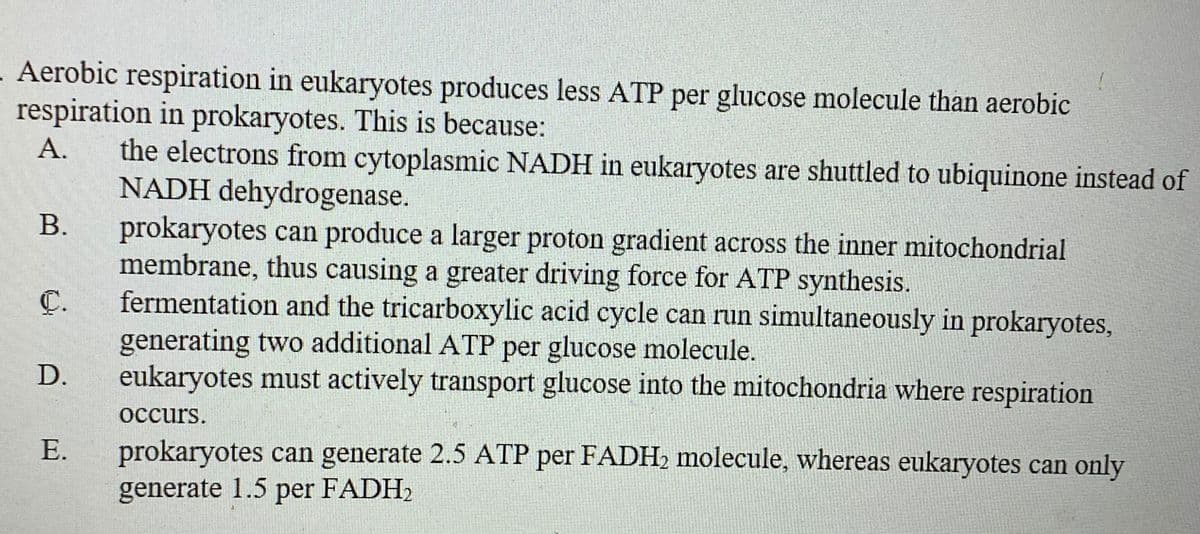Aerobic respiration in eukaryotes produces less ATP per glucose molecule than aerobic respiration in prokaryotes. This is because: А. the electrons from cytoplasmic NADH in eukaryotes are shuttled to ubiquinone instead of NADH dehydrogenase. В. prokaryotes can produce a larger proton gradient across the inner mitochondrial membrane, thus causing a greater driving force for ATP synthesis. fermentation and the tricarboxylic acid cycle can run simultaneously in prokaryotes, С. generating two additional ATP per glucose molecule. eukaryotes must actively transport glucose into the mitochondria where respiration D. осcurs. Е. prokaryotes can generate 2.5 ATP per FADH2 molecule, whereas eukaryotes can only generate 1.5 per FADH,
Aerobic respiration in eukaryotes produces less ATP per glucose molecule than aerobic respiration in prokaryotes. This is because: А. the electrons from cytoplasmic NADH in eukaryotes are shuttled to ubiquinone instead of NADH dehydrogenase. В. prokaryotes can produce a larger proton gradient across the inner mitochondrial membrane, thus causing a greater driving force for ATP synthesis. fermentation and the tricarboxylic acid cycle can run simultaneously in prokaryotes, С. generating two additional ATP per glucose molecule. eukaryotes must actively transport glucose into the mitochondria where respiration D. осcurs. Е. prokaryotes can generate 2.5 ATP per FADH2 molecule, whereas eukaryotes can only generate 1.5 per FADH,
Human Physiology: From Cells to Systems (MindTap Course List)
9th Edition
ISBN:9781285866932
Author:Lauralee Sherwood
Publisher:Lauralee Sherwood
Chapter2: Cell Physiology
Section: Chapter Questions
Problem 10RE: Using the answer code on the right, indicate which form of energy production is being described: 1....
Related questions
Topic Video
Question

Transcribed Image Text:Aerobic respiration in eukaryotes produces less ATP per glucose molecule than aerobic
respiration in prokaryotes. This is because:
the electrons from cytoplasmic NADH in eukaryotes are shuttled to ubiquinone instead of
NADH dehydrogenase.
prokaryotes can produce a larger proton gradient across the inner mitochondrial
membrane, thus causing a greater driving force for ATP synthesis.
fermentation and the tricarboxylic acid cycle can run simultaneously in prokaryotes,
generating two additional ATP per glucose molecule.
eukaryotes must actively transport glucose into the mitochondria where respiration
А.
B.
C.
D.
occurs.
prokaryotes can generate 2.5 ATP per FADH2 molecule, whereas eukaryotes can only
generate 1.5 per FADH2
Е.
E.
Expert Solution
This question has been solved!
Explore an expertly crafted, step-by-step solution for a thorough understanding of key concepts.
This is a popular solution!
Trending now
This is a popular solution!
Step by step
Solved in 2 steps

Knowledge Booster
Learn more about
Need a deep-dive on the concept behind this application? Look no further. Learn more about this topic, biology and related others by exploring similar questions and additional content below.Recommended textbooks for you

Human Physiology: From Cells to Systems (MindTap …
Biology
ISBN:
9781285866932
Author:
Lauralee Sherwood
Publisher:
Cengage Learning


Human Physiology: From Cells to Systems (MindTap …
Biology
ISBN:
9781285866932
Author:
Lauralee Sherwood
Publisher:
Cengage Learning
